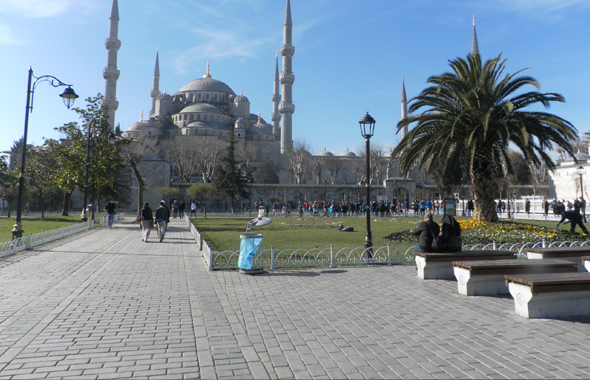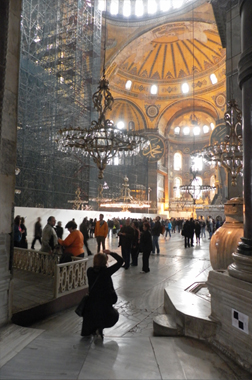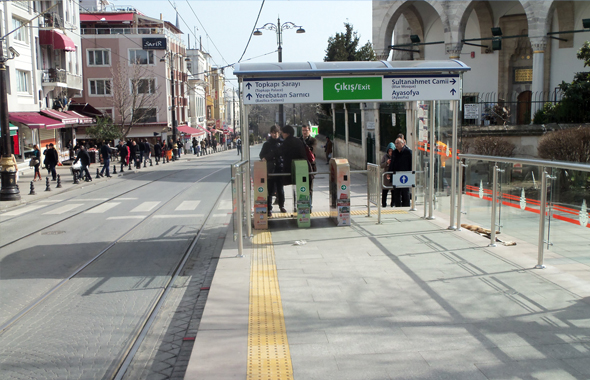Tram Riders, Bridge Anglers and Gypsy Children in Istanbul
By Jawahar Malhotra
ISTANBUL, Turkey: The tram token machine besides the back edge of the sidewalk had taken my 5TL (for Turkish Lira) note and was now asking a question in Turkish. The right button had an OK below it, the left one was more incomprehensible, so I hit ‘OK’ and guessed right. In the slot below dropped two 1TL coins and a 3TL ($1.40) plastic red token, the fare along the entire length of the tram system.
I clutched it and strode to the turnstile, puzzled at where it would go. Puzzled because the turnstiles were just one step above the pavement at the SultanAhmet station, just three short streets away from the Hippodrome and the SultanAhmet Mosque (better known as the Blue Mosque) and the Hagia Sophia Museum, and almost across from the Basilic Cistern. Would it go in the turnstile or in the tram itself since the station is open from the road, I wondered, as one could just as easily saunter in from the road and use the token. A young college kid saw my dilemma and said in halting, accented English, “It goes here”, pointing to the slot below the magnetic card reader pad. “Thanks”, I managed feeling foolish about not doing so in the first place.
Inside, I stood by the bi-fold doors and to the front of the first carriage. Behind the drivers glassed in cabin, a pack of six young kids were noisily prattling away, the youngest perhaps five years old, with hairy eyebrows that formed a line with pointy corners, dark features and complexion and not very tall. Obviously delighted at the tram ride, he grinned mischievously, eyes bright with fun, at the others who were talking loudly, a tall girl with brown pigtails and a skyblue printed dress over black slacks leading them on.
After the next stop, Gulhane, a man by the door got up to leave and the one next to him at the window stood up, half perched against the handrail, turned to the kids and shouted at them “Kapa cheneni, Kapa cheneni”! (Keep quite!) much to the shock of the other passengers. The man across from me retorted in Turkish in a firm, calming tone, suggesting to the man that these were just kids. The first one looked up, towards him, with the look of a slightly deranged and mentally challenged person, and blurted out with a slight stoop of his mouth and shouted back, trading barbs, then sat down. The kids stopped for a minute, then tittered and carried on, a little softer.
At the next stop, Sirkeci, a station monitor with a yellow safety vest, on the outside platform spied the kids – perhaps the driver had radioed ahead – and tapped loudly at the window as the doors opened, motioning to the kids to get out. They looked startled, he poked his head in and chided, as if to say “come on, move out, all of you, you imps riding around for free”. He had apparently seen them before, and scolded them as they walked out, the girl, two tall boys and two smaller girls and the eyebrowed boy, who gave a shrug of his shoulders and an amused look as he trailed behind them all. They walked onto the station pavement and through the exit turnstile.
I wondered, if this had been America, these kids would have been dragged off by a security official, if the deranged man would have been escorted away. In Istanbul, the tram guards were vexed, as if they were used to the nuisance, and let them off with a scolding. The deranged man got off a stop later, on the other side of the Galata Bridge, at Karakoy; the other man looked away and I kept a lookout for my station, Tophane, coming ahead.
The honor system in paying for the tram ride when one could just as well jump on without going through the turnstiles was something I was unprepared for in my concept of Istanbul, just as the cleanliness and organization was unexpected. Some stations had monitors, but the smaller ones did not. Finding that the city was both very Asian in the warmth, expressiveness, friendliness and politeness of its people, yet quite European in its fashion sense and lifestyle was unexpected. Shopkeepers were aggressive but thankfully not persistent or insistent like in other Asian countries. The “sh’, “ch”, “kh” and slight lisp of the language, with words mixed in from Persian, Arabic and a few other tongues made Turkish sound like Farsi sometimes and Slavic at others.
It was a long walk, later that evening, from the Istanbul Museum of Modern Art by the edge of the Bosphorous. I had to climb the steep hill upto the Galata Tower only to discover that it cost 65TL (about $30) to get to top for a view and perhaps eat at the expensive, tiny restaurant there. Deciding I had better use for my money, I trudged down the steep hill, partway on stone steps with a pipe handrail, and walked through the area strewn with machine parts, plumbing parts, handtools, electrical parts and repair shops. The gaunt, lanky man sitting on the stone step of a building by the main road Sabahattin Evren Caddesi, walked up to me as I looked at his wares displayed propped up on the sidewalk and asked what I needed. “China”? I inquired, looking at the handtools. “Chine, Inde, Allemange”, he replied, “Taiwan”.
I turned and walked on, crossing the road, and past the rows of plumbing parts shops, chrome-plated fixtures shining in the late afternoon light. A turn southwards on Karakoy station led me to the Galata Bridge for a walk across the mouth of the Halic (Golden Horn) River.
On both sides of the approach to the midsection of the bridge where boats passed under, a wall of determined anglers had their rods perched along the broad handrail, a home crafted long wooden bracket with a v-notch holding the rods in place, as the lines dangled 100 feet below into the water. Their baits were in a small bucket and their catches of 16-inch long whitefish lay in another larger plastic trough. Some were luckier than others; and most knew their neighbors, suggesting they met frequently on this spot to while away the afternoon. Two men sat on the stone guardstone of the road and cut bait into chunks. Impressed by one man’s catch, I paused for a while, and a middle-aged man next to him exclaimed jestingly, teasingly, “Professional”!
It was a Tuesday afternoon, and close to the ferry station at Halic Iskelesi, there was a throng of people, many just strolling to take in the day, take pictures and crowd watch. In the underground passageway below the busy Ragip Gumuspala Caddesi thoroughfare, rows of built-in shops lined each side as the throng passed through, hawking plastic toys, cheap belts, souvenirs and other impulse buy items.
The other side opened up a flight of stairs to the plaza by the Yeni Mosque in front and the covered Spices Bazaar to the right. An orange colored campaign truck by the side of the road played loud, catchy music, reverberating across the plaza, sloganing for President Erdogan, a giant screen above showing a video cartoon. The hawkers selling on the spot, semi-peeled, roasted chestnuts and boiled corn on the cobb did good business; I bought my pack of chestnuts, a fondness for which I acquired as a boy in London. Passing through the crowd, I turned as a teenage girl with a tight headscarf and long coat stopped me and asked imploringly, the only word I could understand was “Arab?”; I shook my head and moved on.
I strode my way back towards Sirkeci station to the gyro restaurant which sold a large chicken variety for 6TL ($2.70), gesturing for them to cook the thin, leavened bread some more, then taking it back with me to the hotel near the Kennedy Caddesi, a fifteen minute walk away, along the same path I had used in the morning, past Baslic Cistern, the Hagia Sophia, the SultanAhmet Mosque and the two Obeliks.
As I made the turn off the Hippodrome, at the head of the hill, I heard an angry young voice and saw a girl threaten a boy with a short baton sized stick. It was the brown, pigtailed girl from the tram in the morning, and her cohort of five others. Giggling, with his bright black eyes and bushy straight lines eyebrows, the little boy hopped and jumped towards her. Not of the same features as the rest of the light-skinned Turks, it struck me who they were. Gypsies. Street smart on the roads alone all day. Not a parent in sight. They must have roamed all day and mad it back from the railway station by the water’s edge.




